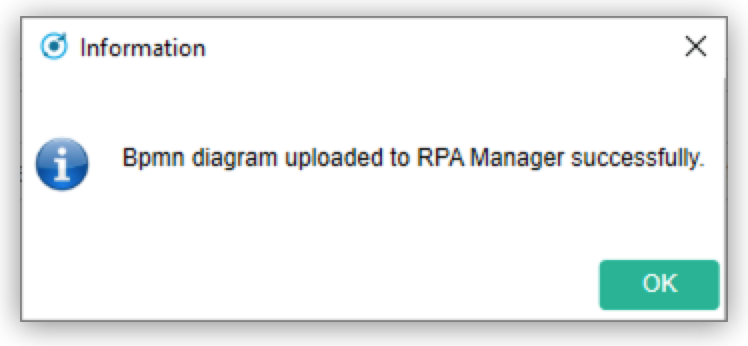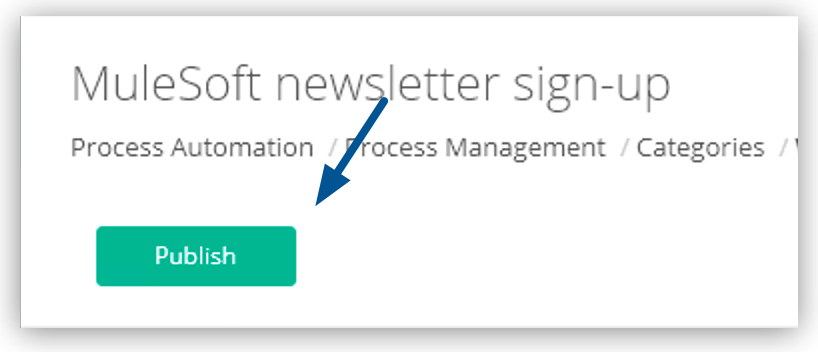Step 4. Design the BPMN Diagram for the Automation
After creating a new automation project, you can start designing the BPMN diagram for the process to automate. You can create the diagram manually or by using the RPA Recorder, which records your actions, creates each corresponding step in the diagram, and generates the action steps based on your mouse and keyboard interactions.
Step 4.1: Open the Project for Editing and Start RPA Recorder
Follow these steps to edit your process BPMN diagram using RPA Recorder:
-
In the navigation panel of RPA Manager, click the My RPA module.
-
Click My Backlog.
-
Search for the MuleSoft newsletter sign-up project in the process list and click the Open process (
 ) button.
) button. -
In the Automation panel, click the Record BPMN (
 ) button.
) button.
If you see a pop-up window asking for permission, select the checkbox to allow RPA Manager to open RPA Recorder and click Open.
-
Provide your RPA Manager user account password and click Login.
Step 4.2: Record Activity Steps with RPA Recorder
After you log in to RPA Recorder, you can start the activity recording process. In this process, you alternate between adding activity steps in RPA Recorder and performing the actual actions in your computer that you want to record and include in the BPMN diagram. This procedure continues until you perform the last action and finish the recording.
Before you Begin Recording the Process
To prevent issues during the tutorial, before you start with the recording steps:
-
Navigate to https://blogs.mulesoft.com/signup-for-our-newsletter/.
-
If a Cookie Consent pop-up shows, accept the cookies.
Performing this action prevents the pop-up from showing during the next steps of the automation tutorial, which could prevent you from finishing the process successfully.
Start the Recording
To record actions with RPA Recorder and create the BPMN diagram, follow these steps:
-
In RPA Recorder, click the Start Recording (
 ) button and add the first activity step:
) button and add the first activity step:-
In the activity name field, write
Open newsletter sign-up page. -
In the drop down menu, select Web task.
-
Click Add.
-
In the browser session that opens, navigate to
https://blogs.mulesoft.com/signup-for-our-newsletter/.
-
-
In the RPA Recorder panel, click the Add activity (
 ) button and add a new activity step:
) button and add a new activity step:
-
Write
Sign-up for newsletterin the activity name field. -
In the drop down menu, select Web task.
-
Select the Continue with already existing web session checkbox.
This option creates the
generatedWebSession1Action Parameter, which enables you to continue using the same web session in subsequent Web tasks. You can also reference this parameter when you create new action steps during the build phase in RPA Builder. -
Click Add
-
In the sign-up page, provide an email address of your choice and click Sign up.
-
-
In the RPA Recorder panel, click the Stop recording (
 ) button.
) button. -
Confirm that RPA Recorder generates a BPMN diagram as follows:

After you finish the recording process, upload the newly-created BPMN diagram to RPA Manager to update the model of your current automation project.
Step 4.3: Upload the BPMN Diagram to RPA Manager
Follow these steps to upload the BPMN diagram created with RPA Recorder to RPA Manager:
-
In RPA Recorder, click the Edit, Merge and Upload Recordings (
 ) button.
) button. -
In the Automation panel, click the Save (
 ) button.
) button. -
Write
MuleSoft Newsletterin the Process name field and click Save. -
Click the Upload to server (
 ) button.
) button. -
In the confirmation window that shows after the upload finishes successfully, Click OK.

-
Close the RPA Recording Editor window.
-
Close the RPA Recorder window.
-
Return to RPA Manager and refresh the browser page.
-
Click Publish.

-
Click the confirmation checkbox and then click Release to Build.
Next Steps
Now that you’ve created a BPMN diagram for your automation project and published it, it’s time to move to the build phase, in which you can edit the diagram and specify the actions to execute for each action step.
Continue with Step 5: Build the automation from the BPMN diagram



